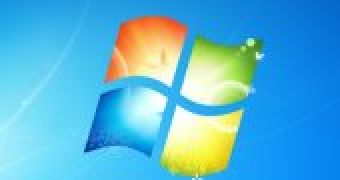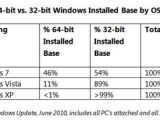Almost 1 in 2 customers running the latest iteration of the Windows client are using systems with 64-bit (x64) architectures and 64-bit (x64) copies of Windows 7. According to statistics provided by the Redmond company, no less than 46% of all Windows 7 PCs worldwide are equipped with a 64-bit edition of the operating system, as of June 2010. It appears that with the advent of Windows Vista’s successor, x64 adoption has surged, approximately half of all machines now sporting the 64-bit flavor of Windows 7.
Still, the 32-bit (x86) variants of the operating system continue to represent the majority of Windows 7 copies running around the world. But while the installed base for 32-bit Windows 7 is 54%, the percentage is dwindling, as x64 processors are increasingly used in new systems, fueling the adoption boost for x64 Windows 7. “Compared to Windows Vista at 3 and a half years after launch, only 11% of PCs running Windows Vista worldwide are running 64-bit. With Windows 7, running a 64-bit OS is becoming the norm,” revealed Brandon LeBlanc, Windows Communications Manager on the Windows Client Communications Team.
No less than 89% of Vista computers worldwide are running x86 versions of the operating system. However, it was Vista in the first place that kick started the explosion of x64 adoption. 64-bit processors were available to end users long before Windows Vista hit store shelves in January 2007, but they failed to gain any real traction, even though Microsoft did produce an x64 version of Windows XP. To this day, only 1% of Windows XP computers are 64-bit.
“A primary benefit of 64-bit Windows is the increase in addressable memory. This makes more “bits” available to Windows (the OS), which means more information can be “addressed” at once. 32-bit architectures have a memory ceiling of 4GB while the 64-bit architecture increases the memory ceiling to approximately 17.2 billion GB or RAM! Windows 7 is designed to use up to 192 GB of RAM, a huge jump compared to limits with all 32-bit systems,” LeBlanc added.
There are additional benefits to running x64 Windows, especially related to security. Just as 64-bit Vista, 64-bit Windows 7 too offers evolved Address Space Layout Randomization (ASLR) and Data Execution Prevention (DEP), which help better protect computers from attacks. In addition, x64 Windows 7 and Vista also come with PatchGuard (kernel patch protection), a feature which limits the access of third-parties to the core of the OS for patching, but also with mandatory signed drivers, and additional mitigations designed to boost security.
Windows 7 RTM Enterprise 90-Day Evaluation is available for download here.

 14 DAY TRIAL //
14 DAY TRIAL // 
